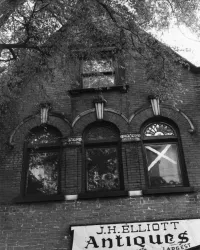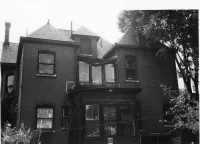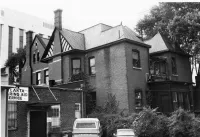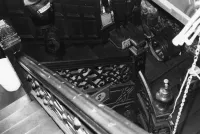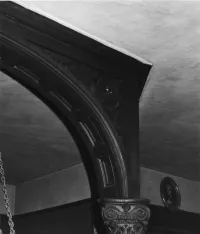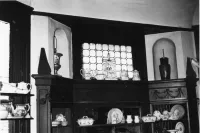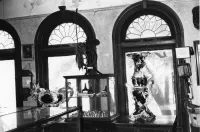Share what you know,
and discover more.
Share what you know,
and discover more.
Sep 20, 1977
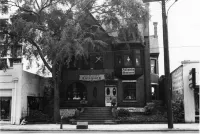
-

- Charmaine Bantugan
National Register of Historic Places - Rufus M. Rose House (J.H. Elliott Antiques)
Statement of Significance: The Rufus M. Rose House is significant as one of the few, last remaining Victorian mansions on Peachtree Street and as the home of the originator of Four Roses liquor. It was from the R. M. Rose and Company, one of the largest liquor distillers and distributors in the Atlanta area, that the idea of 'Four Roses' was used in 1905 and became a registered trademark in 1906. The Four Roses liquor carries this name today and is nationally known. According to Dr. R. M. Rose's obituary in the Atlanta Constitution, July 22, 1910, he was "born May 17, 1836, in Willimantic, Conn., of an old and influential New England family. Receiving an academic education in his native city, he later went to New York City, entered the drug business and filled an important appointment at the Sailors' hospital on Long Island. Later he studied medicine, attending lectures at the College of Physicians and Surgeons, and received his diploma. While still a young man, he came to Hawkinsville, Georgia, and entered the drug business with his uncle, D. H. Mathewson, a prominent Georgian. When the war between the states came on, Dr. Rose was among the first to volunteer, joining the cause of the south and enlisting in the Tenth Georgia regiment of the confederate army. Although at first engaged in the field, he was soon transferred to the medical department, serving in the old converted hospital of William and Mary College, and later in the laboratory at Macon. Returning south at the close of the war, he came to Atlanta, and from the very first was prominently identified with the progress, enterprise, and push of this struggling city. In 1867 he organized the R. M. Rose & Co., shortly afterwards changed to R.M. Rose Co., and continued at the head of this firm until a few years ago, when he retired, and was succeeded by his son, Randolph Rose. Such was the reputation of this house, that the label of any goods was the name as his bond, and it received the highest recommendation ever given by the government, and was one of only two houses in the country to receive such a distinction. Since his retirement, Dr. Rose had been a familiar figure on Atlanta streets as he attended to his large real estate business to the very last." The R. M. Rose and Co. was first listed in the Atlanta City Directory in 1870. Dr. Rose "had a large distillery at Vinings, Georgia, and made his liquor there. He sold wine but did not make any himself. He sold rye and corn and was very proud of the fact that he did not color his corn it was a clear liquid and not yellow. The liquor ads in the Atlanta papers stressed the fact that ladies could come into his store because there was no saloon attached and no drinking or sampling was ever done on the premises. Mrs. Snipes said the liquor was kept in large casks and was drawn from them into bottles or jugs. It was cheaper to buy by the jug. Prices ranged from a 6-year-old Rye at $1.00 a quart to "Rose's Private Stock" at $7.00 a jug. In 1904 Rose's Reserve Stock Corn Whiskey was awarded a gold medal at the St. Louis Exposition. It was the only whiskey awarded a gold medal. Rufus' slogan was "Ask the Revenue Officer" implying that he would tell you that Rose Liquor was the purest, safest drink you could buy. The use of four roses first appeared in the month of December, 1905. It appeared at the top of every ad for that month. In 1906 a registered trademark appeared which had a shield with a large "R" in the middle, "Purity Guaranteed" above the R, "trade mark" below the R, "Ask the Revenue Officer" below the shield, and two roses on each side of the shield. So, for whatever reason the four roses were chosen, it is a fact that they were using the four roses as early as 1905 when all the family was living at 481 Peachtree (now 537) and had it made into a trade mark by 1906. Four Roses is a blend and was probably the last blending that R. M. Rose did before he died. He was the only one able to do it and he had an interest in the business until he died. Randolph, his son, sold out to the Paul Jones Co. and they were using the brand as early as 1913 and Seagram and Co. records state that Paul Jones bought the Four Roses brand, 'even then acquiring a growing reputation as America's most glorious whiskey.' Randolph Rose moved the company to Chattanooga in 1907 because Atlanta and all of Georgia went dry on January 1, 1908." There are several legends about how the name 'Four Roses' came into existence. One suggests the true version was acquired when four girls arrived dressed alike and each wearing four roses, thus the basis for the name of a new product, Four Roses. Another more probable legend suggests that 'Four Roses' was named for Rufus M. Rose, his brother Origen (who was associated with the liquor business) and their sons. A 1906 Atlanta Constitution advertisement reports of the R. M. Rose & Co. whiskey as a valuable medicine "and when used in moderation, its effect on the human system is wholesome and beneficial." It was also said to be "the best and purest medicinal whiskies obtainable." The R. M. Rose House remained in the Rose family until the mid-1920s. The family. of the present owner acquired the Rose House in 1945 and is known as J. H. Elliott Antiques. Architecturally, it is significant as one of the last major examples of the grand residences that once lined Peachtree Street.
National Register of Historic Places - Rufus M. Rose House (J.H. Elliott Antiques)
Statement of Significance: The Rufus M. Rose House is significant as one of the few, last remaining Victorian mansions on Peachtree Street and as the home of the originator of Four Roses liquor. It was from the R. M. Rose and Company, one of the largest liquor distillers and distributors in the Atlanta area, that the idea of 'Four Roses' was used in 1905 and became a registered trademark in 1906. The Four Roses liquor carries this name today and is nationally known. According to Dr. R. M. Rose's obituary in the Atlanta Constitution, July 22, 1910, he was "born May 17, 1836, in Willimantic, Conn., of an old and influential New England family. Receiving an academic education in his native city, he later went to New York City, entered the drug business and filled an important appointment at the Sailors' hospital on Long Island. Later he studied medicine, attending lectures at the College of Physicians and Surgeons, and received his diploma. While still a young man, he came to Hawkinsville, Georgia, and entered the drug business with his uncle, D. H. Mathewson, a prominent Georgian. When the war between the states came on, Dr. Rose was among the first to volunteer, joining the cause of the south and enlisting in the Tenth Georgia regiment of the confederate army. Although at first engaged in the field, he was soon transferred to the medical department, serving in the old converted hospital of William and Mary College, and later in the laboratory at Macon. Returning south at the close of the war, he came to Atlanta, and from the very first was prominently identified with the progress, enterprise, and push of this struggling city. In 1867 he organized the R. M. Rose & Co., shortly afterwards changed to R.M. Rose Co., and continued at the head of this firm until a few years ago, when he retired, and was succeeded by his son, Randolph Rose. Such was the reputation of this house, that the label of any goods was the name as his bond, and it received the highest recommendation ever given by the government, and was one of only two houses in the country to receive such a distinction. Since his retirement, Dr. Rose had been a familiar figure on Atlanta streets as he attended to his large real estate business to the very last." The R. M. Rose and Co. was first listed in the Atlanta City Directory in 1870. Dr. Rose "had a large distillery at Vinings, Georgia, and made his liquor there. He sold wine but did not make any himself. He sold rye and corn and was very proud of the fact that he did not color his corn it was a clear liquid and not yellow. The liquor ads in the Atlanta papers stressed the fact that ladies could come into his store because there was no saloon attached and no drinking or sampling was ever done on the premises. Mrs. Snipes said the liquor was kept in large casks and was drawn from them into bottles or jugs. It was cheaper to buy by the jug. Prices ranged from a 6-year-old Rye at $1.00 a quart to "Rose's Private Stock" at $7.00 a jug. In 1904 Rose's Reserve Stock Corn Whiskey was awarded a gold medal at the St. Louis Exposition. It was the only whiskey awarded a gold medal. Rufus' slogan was "Ask the Revenue Officer" implying that he would tell you that Rose Liquor was the purest, safest drink you could buy. The use of four roses first appeared in the month of December, 1905. It appeared at the top of every ad for that month. In 1906 a registered trademark appeared which had a shield with a large "R" in the middle, "Purity Guaranteed" above the R, "trade mark" below the R, "Ask the Revenue Officer" below the shield, and two roses on each side of the shield. So, for whatever reason the four roses were chosen, it is a fact that they were using the four roses as early as 1905 when all the family was living at 481 Peachtree (now 537) and had it made into a trade mark by 1906. Four Roses is a blend and was probably the last blending that R. M. Rose did before he died. He was the only one able to do it and he had an interest in the business until he died. Randolph, his son, sold out to the Paul Jones Co. and they were using the brand as early as 1913 and Seagram and Co. records state that Paul Jones bought the Four Roses brand, 'even then acquiring a growing reputation as America's most glorious whiskey.' Randolph Rose moved the company to Chattanooga in 1907 because Atlanta and all of Georgia went dry on January 1, 1908." There are several legends about how the name 'Four Roses' came into existence. One suggests the true version was acquired when four girls arrived dressed alike and each wearing four roses, thus the basis for the name of a new product, Four Roses. Another more probable legend suggests that 'Four Roses' was named for Rufus M. Rose, his brother Origen (who was associated with the liquor business) and their sons. A 1906 Atlanta Constitution advertisement reports of the R. M. Rose & Co. whiskey as a valuable medicine "and when used in moderation, its effect on the human system is wholesome and beneficial." It was also said to be "the best and purest medicinal whiskies obtainable." The R. M. Rose House remained in the Rose family until the mid-1920s. The family. of the present owner acquired the Rose House in 1945 and is known as J. H. Elliott Antiques. Architecturally, it is significant as one of the last major examples of the grand residences that once lined Peachtree Street.
Sep 20, 1977
National Register of Historic Places - Rufus M. Rose House (J.H. Elliott Antiques)
Statement of Significance:The Rufus M. Rose House is significant as one of the few, last remaining Victorian mansions on Peachtree Street and as the home of the originator of Four Roses liquor. It was from the R. M. Rose and Company, one of the largest liquor distillers and distributors in the Atlanta area, that the idea of 'Four Roses' was used in 1905 and became a registered trademark in 1906. The Four Roses liquor carries this name today and is nationally known.
According to Dr. R. M. Rose's obituary in the Atlanta Constitution, July 22, 1910, he was "born May 17, 1836, in Willimantic, Conn., of an old and influential New England family. Receiving an academic education in his native city, he later went to New York City, entered the drug business and filled an important appointment at the Sailors' hospital on Long Island. Later he studied medicine, attending lectures at the College of Physicians and Surgeons, and received his diploma. While still a young man, he came to Hawkinsville, Georgia, and entered the drug business with his uncle, D. H. Mathewson, a prominent Georgian. When the war between the states came on, Dr. Rose was among the first to volunteer, joining the cause of the south and enlisting in the Tenth Georgia regiment of the confederate army. Although at first engaged in the field, he was soon transferred to the medical department, serving in the old converted hospital of William and Mary College, and later in the laboratory at Macon. Returning south at the close of the war, he came to Atlanta, and from the very first was prominently identified with the progress, enterprise, and push of this struggling city. In 1867 he organized the R. M. Rose & Co., shortly afterwards changed to R.M. Rose Co., and continued at the head of this firm until a few years ago, when he retired, and was succeeded by his son, Randolph Rose. Such was the reputation of this house, that the label of any goods was the name as his bond, and it received the highest recommendation ever given by the government, and was one of only two houses in the country to receive such a distinction. Since his retirement, Dr. Rose had been a familiar figure on Atlanta streets as he attended to his large real estate business to the very last."
The R. M. Rose and Co. was first listed in the Atlanta City Directory in 1870. Dr. Rose "had a large distillery at Vinings, Georgia, and made his liquor there. He sold wine but did not make any himself. He sold rye and corn and was very proud of the fact that he did not color his corn it was a clear liquid and not yellow. The liquor ads in the Atlanta papers stressed the fact that ladies could come into his store because there was no saloon attached and no drinking or sampling was ever done on the premises. Mrs. Snipes said the liquor was kept in large casks and was drawn from them into bottles or jugs. It was cheaper to buy by the jug. Prices ranged from a 6-year-old Rye at $1.00 a quart to "Rose's Private Stock" at $7.00 a jug. In 1904 Rose's Reserve Stock Corn Whiskey was awarded a gold medal at the St. Louis Exposition. It was the only whiskey awarded a gold medal. Rufus' slogan was "Ask the Revenue Officer" implying that he would tell you that Rose Liquor was the purest, safest drink you could buy. The use of four roses first appeared in the month of December, 1905. It appeared at the top of every ad for that month. In 1906 a registered trademark appeared which had a shield with a large "R" in the middle, "Purity Guaranteed" above the R, "trade mark" below the R, "Ask the Revenue Officer" below the shield, and two roses on each side of the shield. So, for whatever reason the four roses were chosen, it is a fact that they were using the four roses as early as 1905 when all the family was living at 481 Peachtree (now 537) and had it made into a trade mark by 1906. Four Roses is a blend and was probably the last blending that R. M. Rose did before he died. He was the only one able to do it and he had an interest in the business until he died. Randolph, his son, sold out to the Paul Jones Co. and they were using the brand as early as 1913 and Seagram and Co. records state that Paul Jones bought the Four Roses brand, 'even then acquiring a growing reputation as America's most glorious whiskey.' Randolph Rose moved the company to Chattanooga in 1907 because Atlanta and all of Georgia went dry on January 1, 1908." There are several legends about how the name 'Four Roses' came into existence. One suggests the true version was acquired when four girls arrived dressed alike and each wearing four roses, thus the basis for the name of a new product, Four Roses. Another more probable legend suggests that 'Four Roses' was named for Rufus M. Rose, his brother Origen (who was associated with the liquor business) and their sons.
A 1906 Atlanta Constitution advertisement reports of the R. M. Rose & Co. whiskey as a valuable medicine "and when used in moderation, its effect on the human system is wholesome and beneficial." It was also said to be "the best and purest medicinal whiskies obtainable."
The R. M. Rose House remained in the Rose family until the mid-1920s. The family. of the present owner acquired the Rose House in 1945 and is known as J. H. Elliott Antiques. Architecturally, it is significant as one of the last major examples of the grand residences that once lined Peachtree Street.
Posted Date
Aug 10, 2023
Historical Record Date
Sep 20, 1977
Source Name
National Register of Historic Places
Source Website
Delete Story
Are you sure you want to delete this story?


